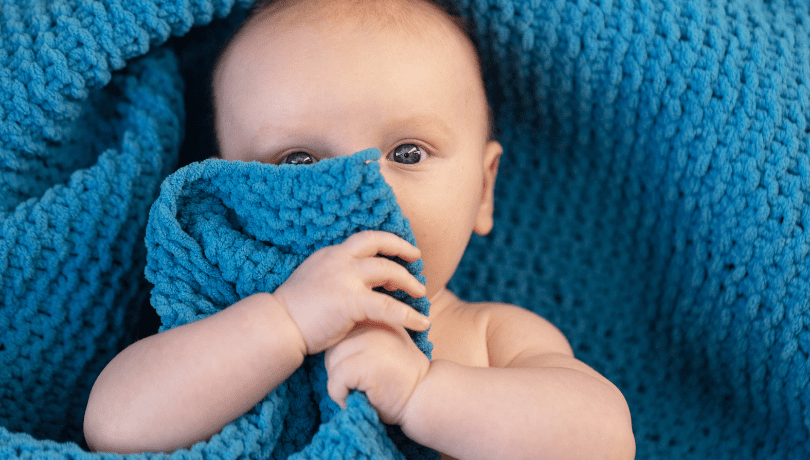Baby’s Receiving Blanket vs Swaddle: What is Better?
A receiving blanket is one of the first things you’ll be introduced to after baby delivery. You’ll notice it’s this thin, soft, cotton blanket, and nurses use this blanket to dry and wrap your newborn baby as they are brought into this world.
But does that mean it’s the same as a swaddling blanket? No, both are two different things.
So, let’s look at the differences between a receiving blanket vs swaddle. I’ll also talk about what you should look for when you buy swaddle blankets and receiving blankets, including the material, how many you’ll need, and more.

Table of Contents
Receiving Blankets
Dear new parents, a newborn’s receiving blanket is an essential for your hospital bag. Many hospitals issue it as well because you will need it immediately after baby delivery.

- At the hospital, nurses will use the receiving blanket to dry and warm your baby after delivery.
- After that, they are used as a cover for skin-to-skin contact, and have many more uses too.
These are lightweight, but warm blankets that are gentle enough for a newborn’s delicate skin. The best part – they are multipurpose. Receiving blankets can be used for swaddling, as a burp cloth, as a surface for diaper changes, etc.,
Weeks before the due date, I and Terry (my husband) would make sure our hospital bag was all prepared, ready to be put in the car instantly. The receiving blanket was an essential item in it, along with the diapers, take-home clothes, infant car seat, swaddle blankets, and more.
Swaddle Blankets
Swaddle blankets are meant for a specific purpose. They are used to snugly wrap your newborn, helping them sleep better.

- These types of stretchy blankets are meant to comfort and soothe your newborn, reduce fussiness, and promote that feeling of safety which makes your baby sleep better for longer.
- They are usually made using cotton, muslin, or bamboo, and have variants – with arm inserts, adjustability, Velcro fastening, zippers, and more.
The gentle and warm pressure from swaddling can also reduce the chances of your baby waking up from the startle reflex. I prefer keeping 1–2 swaddling blankets in my hospital bag, and I love the ones with Velcro fastening.
Receiving Blanket vs Swaddle: 3 Key Differences
Receiving Blanket
- Standard Size – 30 x 30 inches to 30 x 40 inches
- While these are the typical sizes, know that sizes can vary too.
Swaddle
- Standard Size – 40 x 40 inches to 47 x 47 inches
- Swaddling blankets are bigger than receiving blankets and should be no less than 40 x 40 inches for a snug fit.
Receiving Blanket
- They are made of soft, breathable cotton, flannel, or muslin.
- At hospitals, the receiving blankets are made of flannel cotton. There are other blankets that are also made of rayon.
Swaddle
- Good swaddling blankets are made from soft, breathable fabrics like cotton, muslin, or bamboo (or a blend of such materials).
- There are also variants made of polyester and spandex (personally, I don’t prefer them. They are not very breathable, even if stretchy).
Receiving Blanket – Multipurpose
- It can serve multiple purposes and may parents use it for swaddling, for cleaning messes, as a burp cloth, tummy time mat, diaper change mat, breastfeeding cover, car seat cover, wrapping baby after a bath, and many more.
Swaddle – Specific Purpose
- A swaddle blanket is used to help your newborn sleep better. It mimics the snug feeling of the womb to reduce fussiness, and promote more restful sleep.
Recommended Reading: How to Swaddle a Newborn
In addition to deciding between receiving blankets and swaddles, you might also want to consider a baby carrier for a safe, secure, and comfortable way to carry your little one.
Receiving Blanket vs Swaddle: 3 Shopping Tips
Whenever I shop for receiving blankets or swaddles, I focus on breathable fabrics, cloth quality, maintenance, and the minor design details that make life easier for new parents.
Also, it always helps to have at least 3–4 swaddling and receiving blankets just in case some are due for laundry, or if you misplace them a lot like me!
Further Information: How Many Swaddle Blankets Do I Need?
1. Choose From Breathable Fabrics
- Materials like muslin, cotton, bamboo, or a blend of similar breathable fabrics help prevent overheating issues when you swaddle your baby.
- You can also go one step further and look for specific hypoallergenic or organic fabric that are extra gentle on your little one’s sensitive skin.

2. Quality and Easy Maintenance
- I’d suggest that you look for blankets that are machine-washable (and pre-shrunk if possible) because that way, you can focus more on caring for your newborn and less on time-consuming washing.
- It also helps to pay attention to how well it stretches and if it can handle multiple washes without compromising the quality too much.
3. Useful Features
- When I buy a receiving blanket, I look at material, quality, and I pick out the largest size, to keep it for multiple purposes.
- When I purchase swaddle blankets, I ensure that it has other useful features apart from looking at material, size, and quality. I like swaddle blankets with Velcro fastening, but you can also find those that are adjustable, have arm inserts, 2-way zippers, and so on.
Concluding Thoughts on Receiving Blanket vs Swaddle
So, now you know!
Receiving blankets can be used for newborns from the very first days of their lives. It has multiple uses – it can be used to warm or wrap your baby, as a mat for diaper changes, as a burp cloth, etc.,
Swaddling blanket – more special purpose, and is used exclusively to wrap your tiny newborn all cozy and snug, to help them sleep better.
While a receiving blanket can be used as a swaddling blanket, it still helps to keep a few of both in your baby bag to make things easier.
Happy parenting.






